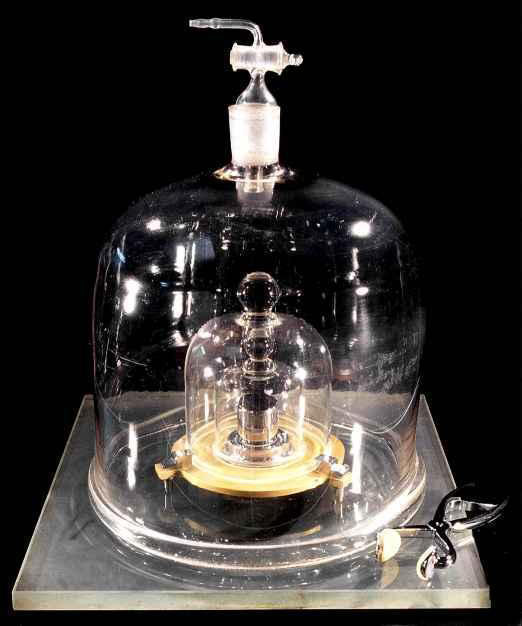
One of the most iconic hunks of metal in the world is set to get a demotion.
The official metallic cylinder that defines the mass of a kilogram may soon be set aside in favor of a measurement that is defined by fundamental constants of nature.
The egg-size alloy of platinum and iridium, known as "Le Grand K," has sat inside a hermetically sealed room in Paris since 1879. Le Grand K serves as the benchmark against which all other kilograms are compared. [The 9 Most Massive Numbers in Existence]
Under lock and key
But Le Grand K has its failings. For one, it must be housed inside three glass bell jars, in a climate-controlled room, under multiple locks and keys. The slightest fleck of dust or smudge of sweat or residue could alter its weight or corrode its surface, changing its mass.
The hunk of metal is only taken out once every 40 years to be compared against similar replicas from around the world.
"The problem with the kilogram in Paris is that it's so precious that people don't want to use it," Stephan Schlamminger, a physicist at the National Institute of Standards and Technology (NIST) in Gaithersburg, Maryland, said in a statement.
Fundamental constants
So for years, physicists have chased an elusive dream: replacing the physical kilogram with a standard inherent in properties of nature such as the speed of light, the wavelength of photons and the Planck constant (also called h-bar), which links the energy a wave carries with its frequency of oscillation. Scientists could use the Planck constant to compare the energy of a wave with Einstein's iconic E=mc^2 equation; in that way, they would determine mass solely through the physical constants.
Sign up for the Live Science daily newsletter now
Get the world’s most fascinating discoveries delivered straight to your inbox.
Unfortunately, no one has yet been able to measure the Planck constant to a level of precision that could rival what has been achieved by using Le Grand K as the benchmark.
But researchers are making strides, and at the current pace, believe they can redefine the kilogram as soon as 2018. In the new study published in the journal Review of Scientific Instruments, Schlamminger and his colleagues measured the Planck constant to a high level of precision using the NIST-4 watt balance, a sophisticated scale that measures a weight by the electromagnetic force that counterbalances it. The electromagnetic force can then be used to calculate the Planck constant.
With that method, the team calculated the Planck constant down to an uncertainty of 34 parts per billion. That result also lines up well with what other teams have calculated.
A separate experiment measuring the atoms in a silicon sphere has calculated Planck's constant down to an uncertainty of 20 parts per billion, while the best watt measurement has achieved an uncertainty of just 19 parts per billion.
All the teams will need to submit their measurements of the Planck constant to the General Conference on Weights and Measures by July 2017; a computer will then calculate a new definition of the kilogram that best matches those measurements.
All of this hard work is unlikely to be noticed when people step on their scales.
"It's the frustrating part about being a metrologist," Schlamminger said. "If you do your job right, nobody should notice."
Even after the kilogram gets its makeover, Le Grand K is unlikely to be completely forgotten, Schlamminger said.
"It's such a symbol and it has such a rich history of measurement. I don't think people will just throw it in the garbage," he said.
Original article on Live Science.

Tia is the managing editor and was previously a senior writer for Live Science. Her work has appeared in Scientific American, Wired.com and other outlets. She holds a master's degree in bioengineering from the University of Washington, a graduate certificate in science writing from UC Santa Cruz and a bachelor's degree in mechanical engineering from the University of Texas at Austin. Tia was part of a team at the Milwaukee Journal Sentinel that published the Empty Cradles series on preterm births, which won multiple awards, including the 2012 Casey Medal for Meritorious Journalism.









